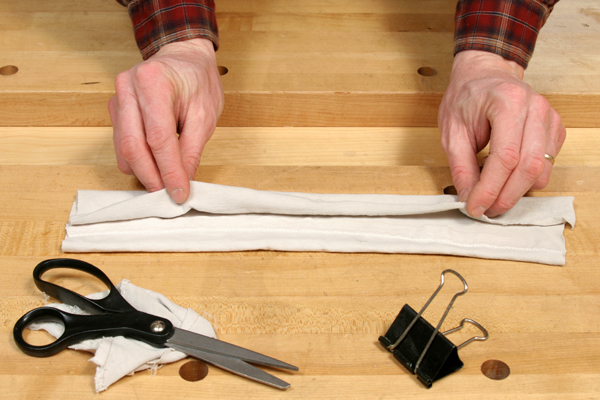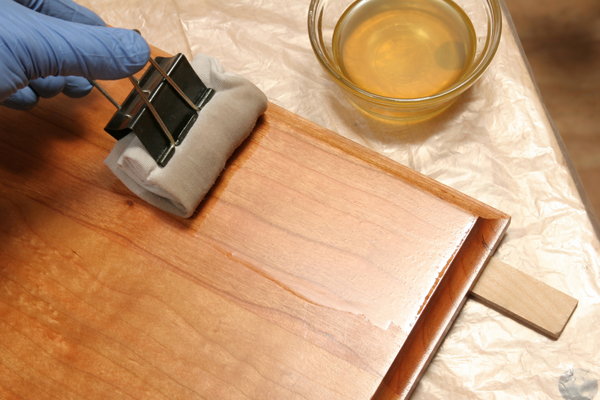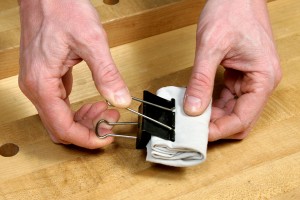
Leave it to Norm Abram to come up with a better way to apply polyurethane. Have you seen him use a big binder clip and a piece of old tee-shirt? If that doesn’t show Yankee frugality, I don’t know what does. But, you know what, it’s an amazingly good applicator. In fact, it’s become my favorite way to apply poly (wiping it on is my next).

If you haven’t seen him use the clip method, here’s how it works: Cut a strip of cotton tee shirt about 3″ wide and maybe 10″ to 12” long. There’s no absolute here…just cut an ample-sized piece. Colored or white both work fine, as long as the shirt is well worn. Fold the long ragged edges in, then fold the whole thing up on itself lengthwise several times to create a pad that’s about 2″ x 2″. Clamp the open side of the pad into a 2″ office binder clip. That’s it. You’ve got a bristle-less brush in about a minute flat.
Here are three reasons why I’m a fan of the “rag bag” brush:
1. Excellent Control
Brushing full-strength poly is like spreading maple syrup around on my project, so I usually cut it back by one-quarter with mineral spirits. But even with a thinned finish, I still tend to get bristle marks here and there where the finish goes on too thick and doesn’t level out. Vertical surfaces are always challenging, and sooner or later I’ll end up getting a drip or a sag. Sure, you can sand or scrape these little problems out, but it adds more hassle to the process.
With Norm’s binder brush, I find it really easy to lay down a thin, consistent coat. You can pull the pad along like a regular brush, which is what I do most of the time, but it’s also possible to push it into corners if you’re careful about it. Since there aren’t any bristles, there won’t be any “track” marks left in your wake. Plus, provided you fold the ragged edges in, and the tee shirt is good and old, you won’t get lint contaminating the finish. The cotton is absorbent enough to hold a sufficient amount of finish without being sopping, and it’s soft enough so you can blend each stroke in nicely with the wet edge of the previous stroke.
Once I’ve applied my full coat, I unclip the pad and use it by hand for those tricky, tight areas. So, the pad has a two-in-one benefit for both broad areas and detail work.
2. No Brush Cleaning
Here’s a huge plus. If you hate to clean brushes, or if you hate seeing a brush you thought you cleaned well enough just get stiff anyway, you’ll love these disposable pads. When I’m done, I just unfold the pad and lay it over the edge of my trash can to dry. No more dunking, squeezing and rinsing. No more wondering what to do with the contaminated cleaner after you’ve cleaned the brush. No more mess.

3. It’s Cheap!
For all intents and purposes, here’s a freebie brush. Who doesn’t have old tee shirts?! But, unlike a cheapo bristle brush, this one actually works right.
Who says you can’t get something for nothing? Definitely try these “rag bag” brushes out on your next poly finish. Once you try it, I’ll bet you don’t buy brushes for varnish anymore. Then, be sure to let me know how they work—or don’t work—for you!
Catch you in the shop,
Chris Marshall, Field Editor





